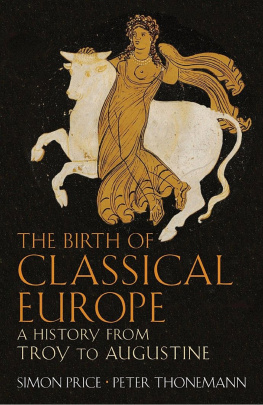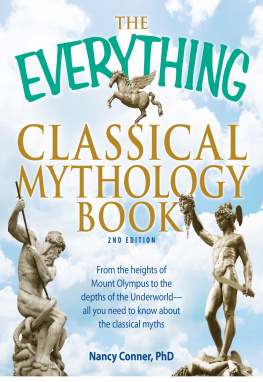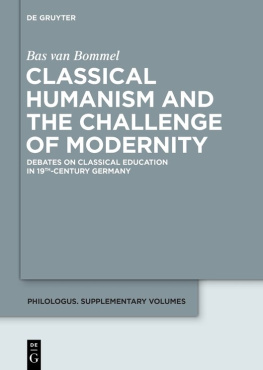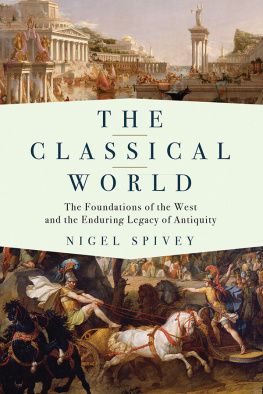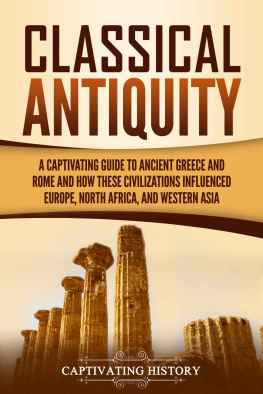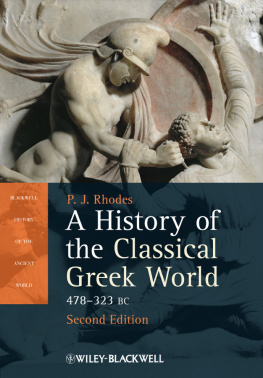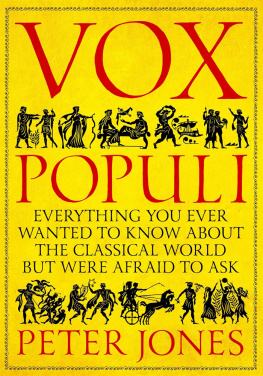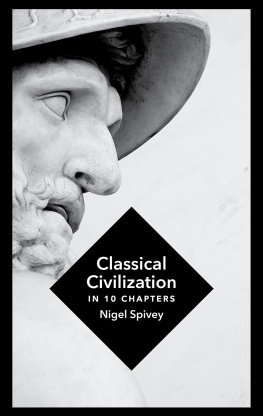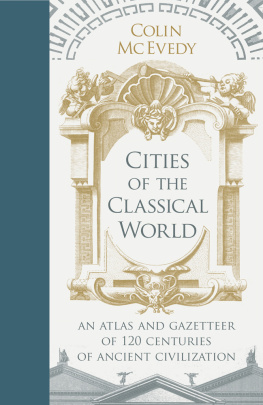THE PENGUIN HISTORY OF EUROPE
General Editor: David Cannadine
I: SIMON PRICE AND PETER THONEMANN
The Birth of Classical Europe: A History from Troy to Augustine
II: CHRIS WICKHAM The Inheritance of Rome:
A History of Europe from 400 to 1000
III: WILLIAM JORDAN Europe in the High Middle Ages
IV: ANTHONY GRAFTON Renaissance Europe, 13501517
V: MARK GREENGRASS Reformation Europe, 15151648
VI: TIM BLANNING The Pursuit of Glory: Europe 16481815
VII: RICHARD J. EVANS Europe 18151914
VIII: IAN KERSHAW Twentieth-Century Europe
already published
SIMON PRICE AND
PETER THONEMANN
The Birth of Classical Europe
A History from Troy to Augustine

ALLEN LANE
an imprint of
PENGUIN BOOKS
ALLEN LANE
Published by the Penguin Group
Penguin Books Ltd, 80 Strand, London WC2R 0RL , England
Penguin Group (USA) Inc., 375 Hudson Street, New York, New York 10014, USA
Penguin Group (Canada), 90 Eglinton Avenue East, Suite 700, Toronto, Ontario, Canada M4P 2Y3 (a division of Pearson Canada Inc.)
Penguin Ireland, 25 St Stephens Green, Dublin 2, Ireland (a division of Penguin Books Ltd)
Penguin Group (Australia), 250 Camberwell Road, Camberwell, Victoria 3124, Australia (a division of Pearson Australia Group Pty Ltd)
Penguin Books India Pvt Ltd, 11 Community Centre, Panchsheel Park, New Delhi 110 017, India
Penguin Group (NZ), 67 Apollo Drive, North Shore 0632, New Zealand
(a division of Pearson New Zealand Ltd)
Penguin Books (South Africa) (Pty) Ltd, 24 Sturdee Avenue, Rosebank 2196, South Africa
Penguin Books Ltd, Registered Offices: 80 Strand, London WC2R 0RL , England
www.penguin.com
First published 2010
Copyright Simon Price and Peter Thonemann, 2010
The moral right of the authors has been asserted
All rights reserved. Without limiting the rights under copyright reserved above, no part of this publication may be reproduced, stored in or introduced into a retrieval system, or transmitted, in any form or by any means (electronic, mechanical, photocopying, recording or otherwise) without the prior written permission of both the copyright owner and the above publisher of this book
ISBN: 978-0-14-194686-3
List of Figures
| 1. |
| 2. |
| 3. |
| 4. |
| 5. |
| 6. |
| 7. |
| 8. | Plan of the Heron at Lefkandi. From M. R. Popham, P. G. Calligas and L. H. Sackett (eds.), Lefkandi II: The Protogeometric Building at Toumba, part 2: The Excavation, Architecture and Finds (London: British School of Archaeology at Athens, 1993), pl. 5, and M. R. Popham with I. S. Lemos, Lefkandi III: The Toumba Cemetery. The Excavations of 1981, 1984, 1986 and 19924 (London: British School of Archaeology at Athens, 1996), pl. 4. |
| 9. |
| 10. |
| 11. |
| 12. |
| 13. | 7, no. 1. Courtesy L. H. Jeffery Archive, Centre for the Study of Ancient Documents, University of Oxford. |
| 14. |
| 15. |
| 16. |
| 17. |
| 18. |
| 19. |
| 20. |
| 21. |
| 22. |
| 23. |
| 24. |
| 25. |
| 26. |
| 27. |
| 28. |
| 29. |
| 30. |
| 31. |
List of Maps
| 1. |
| 2. |
| 3. |
| 4. |
| 5. |
| 6. |
| 7. |
| 8. |
| 9. |
| 10. |
| 11. |
| 12. |
| 13. |
| 14. |
| 15. |
| 16. |
| 17. |
| 18. |
| 19. |
| 20. |
| 21. |
| 22. |
| 23. |
| 24. |
| 25. |
| 26. |
| 27. |
| 28. |
| 29. |
| 30. |
| 31. |
| 32. |
| 33. |
| 34. |
List of Plates
| 1. |
| 2. |
| 3. |
| 4. |
| 5. |
| 6. |
| 7. |
| 8. |
| 9. |
| 10. |
| 11. |
| 12. |
| 13. |
| 14. |
| 15. |
| 16. |
| 17. |
| 18. |
| 19. |
| 20. |
| 21. |
| 22. |
| 23. | Procession of the imperial family on the Ara Pacis, Rome. Height: 1.55 m. Photo: AICT/Allan T. Kohl. |
| 24. |
| 25. |
| 26. |
| 27. |
| 28. |
| 29. |
| 30. |
| 31. | Coins: |
| (a) |
| (b) |
| (c) |
| (d) | Silver coin (tetradrachm) of Mithradates (c. 2.9 cm.), obverse, 89/8 BC . Ashmolean Museum, HCR8002 (= AHFC, pl. 6, no. 57). Photo: Ashmolean Museum, University of Oxford. |
| (e) |
| (f) |
Acknowledgements
We are most grateful to those who have read individual chapters, or even the whole book: Michael Crawford; John Day; Peter Hainsworth; Irene Lemos; Elizabeth Nixon; Lucia Nixon, whose influence on the book is pervasive; Miranda Nixon; John North; Cynthia Shelmerdine; Philip Thonemann; Sarah Thonemann; and Roger Tomlin.
We are indebted to those who have helped us with excursuses on uses of the classical past: Lucy Bailey; Helen Barr; Nicholas Cole; John Day; Michael Dobson; Peter Hainsworth; Clive Holmes; Marie-Chantal Killeen; Bernard ODonoghue; Nicholas Shrimpton; and Jennifer Yee.
In the gathering of images for figures and plates, we are equally indebted to numerous people: William Van Andringa; John Baines; Maureen Basedow; Henry Hurst; Irene Lemos; Simon Loseby; Elizabeth Nixon; Lucia Nixon; Miranda Nixon; Damian Robinson; Eduardo Snchez-Moreno; Bert Smith; Cyrielle Thomas; Andrew Wilson; Greg Woolf; and others who helped us with illustrations that in the end could not be included in this book. We are also grateful to Aneurin Ellis-Evans for composing the index. The extract from The Ruin on pp. 3334 is from Three Old English Elegies, edited by R. F. Leslie (Exeter: University of Exeter Press, new edition, 1988).
Finally, we would like to record the splendidly harmonious and good-humoured nature of the collaboration between the two of us.
Oxford
July 2009
Introduction
In October 2005 a huge steel, bronze and glass sculpture was unveiled outside the seat of the European Parliament in Strasbourg. The sculpture, donated to the European Parliament by the town of Agios Nikolaos on Crete, depicts the mythological princess Europa, cast in bronze, riding on the back of a steel and glass bull. Once upon a time (or so the story goes), the god Zeus fell in love with a beautiful girl named Europa. In order to gain her affections, Zeus turned himself into a magnificent bull, and carried her on his back across the sea to Crete. According to some accounts, one of their three sons was a certain Minos, who became king of Crete. So the Strasbourg sculpture acts as a elegant symbol for the place of Crete in the history of Europe: since Europa later gave her name to the continent of Europe, the Minoan civilization on Crete marks the true beginning of European history.
Next page
